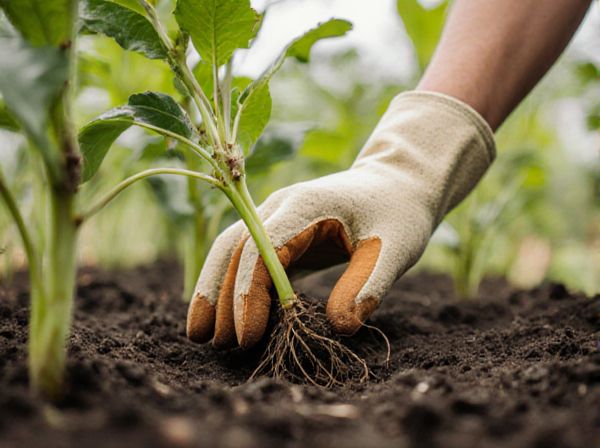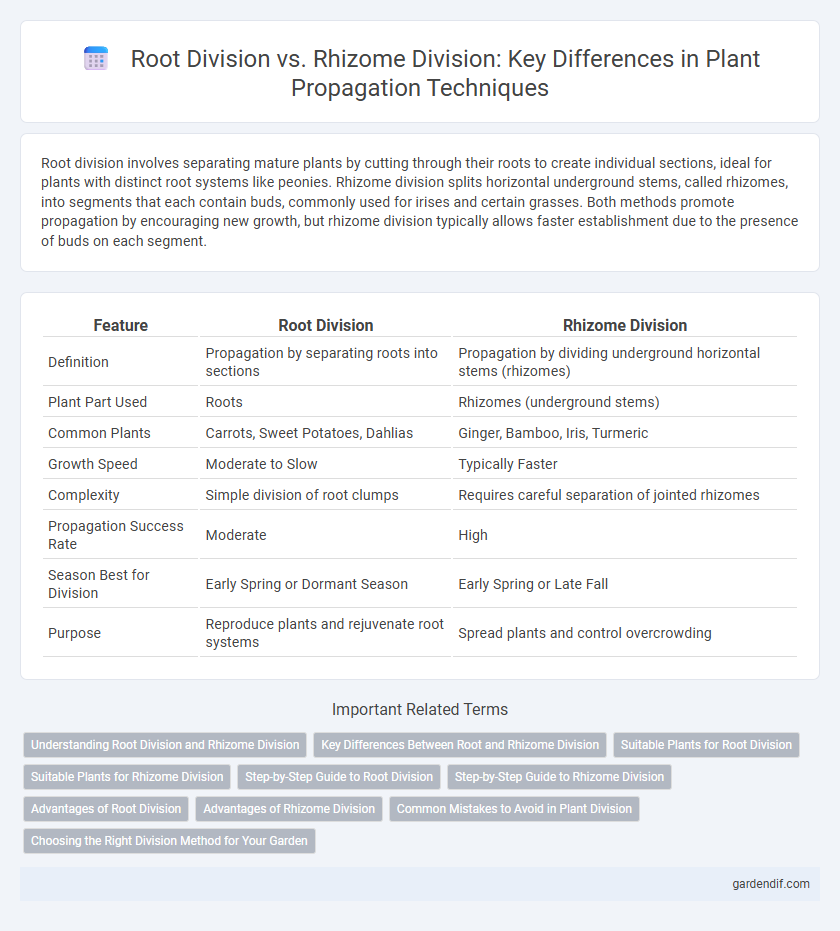
Root Division vs Rhizome Division Illustration
Root division involves separating mature plants by cutting through their roots to create individual sections, ideal for plants with distinct root systems like peonies. Rhizome division splits horizontal underground stems, called rhizomes, into segments that each contain buds, commonly used for irises and certain grasses. Both methods promote propagation by encouraging new growth, but rhizome division typically allows faster establishment due to the presence of buds on each segment.
Table of Comparison
| Feature | Root Division | Rhizome Division |
|---|---|---|
| Definition | Propagation by separating roots into sections | Propagation by dividing underground horizontal stems (rhizomes) |
| Plant Part Used | Roots | Rhizomes (underground stems) |
| Common Plants | Carrots, Sweet Potatoes, Dahlias | Ginger, Bamboo, Iris, Turmeric |
| Growth Speed | Moderate to Slow | Typically Faster |
| Complexity | Simple division of root clumps | Requires careful separation of jointed rhizomes |
| Propagation Success Rate | Moderate | High |
| Season Best for Division | Early Spring or Dormant Season | Early Spring or Late Fall |
| Purpose | Reproduce plants and rejuvenate root systems | Spread plants and control overcrowding |
Understanding Root Division and Rhizome Division
Root division involves separating a plant by cutting its root system into multiple segments, ensuring each segment has sufficient roots and shoots to support growth. Rhizome division splits plants via their horizontal underground stems, called rhizomes, which store nutrients and generate new shoots and roots. Both techniques effectively propagate perennials, but understanding the structural differences between roots and rhizomes is crucial for successful cultivation and plant health.
Key Differences Between Root and Rhizome Division
Root division involves separating a plant's underground roots into sections with buds or shoots, allowing each segment to grow into a new plant. Rhizome division splits horizontal underground stems that store nutrients and produce shoots and roots, facilitating vegetative propagation. Key differences include the structure divided (roots vs. stems), nutrient storage capacity, and growth patterns, with rhizomes typically promoting faster spread and stronger new plant development.
Suitable Plants for Root Division
Root division is suitable for plants with thick, fleshy roots such as dahlias, irises, and peonies, which produce new shoots from established root systems. This method effectively propagates perennial herbs and tuberous plants that store nutrients underground. Root division ensures fast growth and healthy plant development by separating mature root clumps.
Suitable Plants for Rhizome Division
Rhizome division is ideal for plants such as irises, ginger, and mint, which naturally develop underground stems allowing new shoots to emerge from nodes. These plants benefit from rhizome propagation as it promotes vigorous growth and rapid spread. Unlike root division, rhizome division ensures both structural and nutrient support through the horizontal stem segments.
Step-by-Step Guide to Root Division
Root division involves carefully excavating a mature plant to expose its root system, then using sharp tools to split the roots into sections, each containing at least one healthy shoot or bud. After division, plant the sections in well-draining soil enriched with organic matter, water thoroughly, and maintain consistent moisture to encourage new growth. This propagation method is highly effective for perennials like hostas and daylilies, providing robust, genetically identical plants.
Step-by-Step Guide to Rhizome Division
Start rhizome division by carefully digging up the mature plant to expose the rhizomes without causing damage. Use a sharp, sterile knife to cut the rhizomes into sections, ensuring that each section has at least one growing bud or eye. Replant the divided rhizomes at the same depth in well-draining soil, water them thoroughly, and maintain consistent moisture until new growth emerges.
Advantages of Root Division
Root division offers several key advantages in plant propagation, including faster establishment and growth due to the presence of well-developed root systems that enhance nutrient absorption and water uptake. This method also reduces the risk of disease transmission compared to rhizome division, as it involves fewer underground structures that can harbor pathogens. Furthermore, root division ensures genetic consistency and vigor, making it ideal for maintaining desirable plant traits.
Advantages of Rhizome Division
Rhizome division promotes rapid plant multiplication through underground stems, enabling efficient spread and establishment in various soil conditions. This method enhances genetic uniformity and resilience by producing clones identical to the parent plant, ensuring consistent growth traits. Rhizomes store nutrients, supporting vigorous regrowth and improving overall plant survival during adverse environmental conditions.
Common Mistakes to Avoid in Plant Division
Root division often leads to overzealous cutting, which can damage the plant's vascular system and reduce regeneration capacity. Rhizome division mistakes frequently include failing to separate sections with healthy buds, causing weak or no new growth. Avoiding these errors ensures higher success rates in propagation and promotes healthier plant development.
Choosing the Right Division Method for Your Garden
Root division suits plants with thick, fibrous roots and is ideal for shrubs like hostas and daylilies, promoting healthy growth by separating root clumps. Rhizome division works best for plants with horizontal underground stems, such as irises and ginger, ensuring new shoots develop from separated rhizome sections. Selecting the right division method depends on the plant's root structure and growth habits to maximize successful propagation and garden vitality.
Root Division vs Rhizome Division Infographic

 gardendif.com
gardendif.com